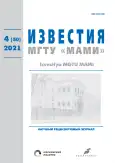Numerical simulation of cavitation in the flow path of a reversible hydraulic machine for a head up to 250m
- Authors: Seleznev V.N.1
-
Affiliations:
- JSC Power Machines
- Issue: Vol 15, No 4 (2021)
- Pages: 43-48
- Section: Original Study Articles
- URL: https://journals.rcsi.science/2074-0530/article/view/105608
- DOI: https://doi.org/10.31992/2074-0530-2021-50-4-43-48
- ID: 105608
Cite item
Full Text
Abstract
In areas where thermal and nuclear power plants are mainly located, the problem of lack of maneuverable capacities, the coverage of peak loads and the passage of periods of reduced energy consumption is solved through the construction of large pumped storage power plants (PSPP). To create highly efficient flow paths for pump-turbines, one of the modern trends is the use of numerical modeling of three-dimensional fluid flow. Nowadays, there are many software products that implement numerical modeling by the finite volume method. The most famous among them are Fluent, CFX, StarCD, Numeca, Flow Vision and CADRUN. Verification of the computational model remains an urgent task. It is important to choose a methodology that will allow you to get an acceptable result with optimal time spent on preparing data and conducting computational studies.
The article examines the flow path of a radial-axial pump-turbine designed for use at a maximum head up to 250m. Numerical modeling of the cavitation process arising in the turbine mode at a significant distance from the optimum of the characteristic was carried out. The calculations were performed using the Ansys CFX software package, version 2021R1. A brief description of the problem statement, the computational grids used and the assumptions made is given. Comparison of calculation results with experimental data is presented. A qualitative comparison of the cavitation origination regions obtained by numerical simulation with the data of monitoring the state of the base metal and welded joints of the hydroelectric unit impeller by the method of non-destructive testing is carried out.
The aim of the work was to present an “economical” technique for numerical simulation of cavitation to determine the places of possible occurrence of cavitation wear. The technique consists in describing the formulation of the problem, the computational grids used and the assumptions made for the optimal use of computing resources without a significant loss in the accuracy of the results.
Full Text
##article.viewOnOriginalSite##About the authors
V. N. Seleznev
JSC Power Machines
Author for correspondence.
Email: Seleznev_VN@power-m.ru
Russian Federation, Saint Petersburg
References
- Sinyugin V.YU., Magruk V.I., Rodionov V.G. Gidroakkumuliruyushchiye elektrostantsii v sovremennoy el-ektroenergetike [Pumped storage power plants in the modern electric power industry]. Moscow: ENAS Publ., 2008. 352 p.
- Krivchenko G.I. Gidravlicheskiye mashiny: Turbiny i nasosy [Hydraulic machines: Turbines and pumps]. Moscow: Energiya Publ., 1978. 320 p.
- Rodrigues Cunha M.A., Villa Nova H.F. CAVITATION MODELING OF A CENTRIFUGAL PUMP IMPELLER // 22nd International Congress of Mechanical Engineering November 03-07, 2013, Ribeirão Petro, São Paulo, Brazil
- D. Somashekar, Dr. H. R. Purushothama Numerical Simulation of Cavitation Inception on Radial FlowPump IOSR Journal of Mechanical and Civil Engineering (IOSRJMCE) ISSN : 2278-1684 Volume 1, Issue 5 (July-August 2012), PP 21-26 www.iosrjournals.org
- Documentation Ansys CFX 2021R1.
Supplementary files












